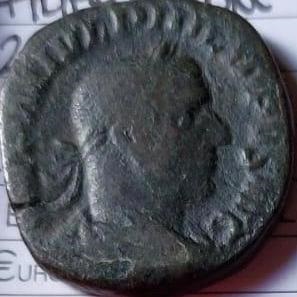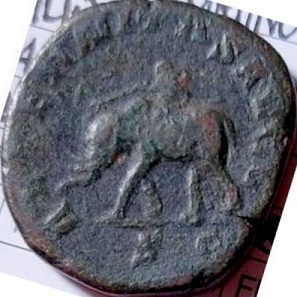|
Roma, 11.11.2023
Egregio
Lettore,
di seguito riporto gli elementi significativi
riguardanti la moneta di figura:
Sesterzio1,
zecca di Roma, 247-249 d. C., RIC IV/III 167a (pag.
89),
Cohen V 18 (pag. 97), indice di rarità
"c".
Descrizione sommaria (sono indicate in rosso le
parti della leggenda usurate o comunque non più
leggibili)
D. IMP M IVL PHILIPPVS AVG2.
Filippo I l'Arabo, busto laureato, paludato e
corazzato a destra.
R. AETERNITAS AVGG3. Elefante gradiente a sinistra,
cavalcato da rettore munito di pungolo e bastone.
S C4
in esergo.
La ricerca nel web di monete della tipologia di
figura ha dato luogo ai seguenti risultati:
- https://www.astetinia.it/it/lot/787/roma-filippo-i-sesterzio-244-249-ae-/
Lotto 787 - Asta Numismatica «Cesare» Base
d'asta: 150,00 EUR Aggiudicazione: 0,00 EUR
Descrizione Roma, Filippo I, Sesterzio, 244-249,
AE (19,84g x 29mm); D/ IMP M IVL PHILIPPVS AVG;
busto laureato, drappeggiato e corazzato. R/
AETERNITAS AVGG; S C; fantino su elefante. RIC
167a; Coh 18. Rovescio attrattivo e ricercato;
bel ritratto; bel modulo. Grading/Stato: BB.
- arsvalue
Philip I (244-249), Sestertius, Rome, 248-9. AE
(g16,14; mm27; h12). IMP M IVL PHILIPPVS AVG,
Laureate, draped and cuirassed bust r.; Rv.
AETERNITAS AVGG, Elephant walking l., guided by
mahout with goad and wand, C S. RIC 167a.
Engraver’s error with CS, not SC, on the
reverse. Green patina, near very fine.
- https://www.cngcoins.com/Coin.aspx?CoinID=376554
438, Lot: 558. Estimate $200. Sold for $425.
Philip I. AD 244-249. Æ Sestertius (30mm,
19.28g, 12h). Ludi Saeculares (Secular Games)
issue, commemorating the 1000th anniversary of
Rome. Rome mint, 1st officina. 10th emission, AD
249. IMP M IVL PHILIPPVS AVG, laureate, draped,
and cuirassed bust right / AETERNITAS AVG, S C
in exergue, elephant advancing left, led by
mahout, holding staff and goad. RIC IV 167a;
Banti 8. VF, green and red-brown patina, some
smoothing. Continuing the tradition of Claudius
and Antoninus Pius before him, the celebration
of the Secular Games at the end of every century
since the founding of Rome culminated during the
reign of Philip I, as the city celebrated her
1,000th anniversary in AD 248. The legends on
these issues frequently read Saeculares Augg,
and feature a similar iconography from previous
games, such as the she-wolf suckling the twins,
the various wild beasts paraded through the
amphitheater, and a cippus inscribed for the
preservation of the memory of these events.
- cngcoins
Electronic Auction 483 Lot number 489 Philip I.
AD 244-249. Æ Sestertius (29mm, 18.81g, 12h).
Ludi Saeculares (Secular Games) issue,
commemorating the 1000th anniversary of Rome.
Rome mint, 1st officina. 10th emission, AD 249.
Electronic Auction 483. Lot: 489. Estimated:
$300. Roman Imperial, Bronze. Sold For $ 700.
Philip I. AD 244-249. Æ Sestertius (29mm,
18.81g, 12h). Ludi Saeculares (Secular Games)
issue, commemorating the 1000th anniversary of
Rome. Rome mint, 1st officina. 10th emission, AD
249. Laureate, draped, and cuirassed bust right
/ AETERNITAS AVGG, C S (sic), elephant advancing
left, guided by mahout, holding goad and wand.
RIC IV 167a; Banti 7. Attractive chestnut brown
patina. Good VF. The die engraver accidentally
reversed the S C in the exergue on the reverse.
Interesting error. Ex CNG Inventory 943723
(March 2013); Robert O. Ebert Collection
(Stack’s Bowers and Ponterio 174, 11 January
2013), lot 5638 (part of). Closing Date and
Time: 6 January 2021 at 12:42:40 ET.
- cngcoins
Electronic Auction 546 Lot nuber 425 Philip I.
AD 244-249. Æ Sestertius (26mm, 21.83g, 12h).
Ludi Saeculares (Secular Games) issue,
commemorating the 1000th anniversary of Rome.
Rome mint, 1st officina. 10th emission, AD 249.
VF. Electronic Auction 546 Lot: 425. Estimated:
$ 150 Roman Imperial, Bronze Sold For $ 300.
Philip I. AD 244-249. Æ Sestertius (26mm, 21.83
g, 12h). Ludi Saeculares (Secular Games) issue,
commemorating the 1000th anniversary of Rome.
Rome mint, 1st officina. 10th emission, AD 249.
Laureate, draped, and cuirassed bust right /
AETERNITAS AVGG, elephant adorned with
saddle-cloth walking left, guided by mahout,
holding goad and wand; SC. RIC IV 167a; Banti 8.
Brown-green patina. VF. Ex Wayne C. Phillips
Estate (Classical Numismatic Group inventory
400440, 2 March 2015). Closing Date and Time: 13
September 2023 at 12:21:20 ET.
- cngcoins
Electronic Auction 547 Lot nuber 946 Philip I.
AD 244-249. Æ Sestertius (27mm, 19.09g, 12h).
Ludi Saeculares (Secular Games) issue,
commemorating the 1000th anniversary of Rome.
Rome mint, 1st officina. 10th emission, AD 249.
Good VF. Electronic Auction 547 Lot: 946.
Estimated: $150. Roman Imperial, Bronze. Sold
For $ 275. Philip I. AD 244-249. Æ Sestertius
(27mm, 19.09g, 12h). Ludi Saeculares (Secular
Games) issue, commemorating the 1000th
anniversary of Rome. Rome mint, 1st officina.
10th emission, AD 249. Laureate, draped, and
cuirassed bust right / Elephant advancing left,
guided by mahout, holding goad and wand. RIC IV
167a; Banti 7. Green patina. Good VF. Ex
Bertolami Fine Arts – ACR 12 (29 October 2014),
lot 918. Closing Date and Time: 4 October 2023
at 15:15:00 ET.
- https://www.romanumismatics.com/274-lot-1149-philip-i-a-sestertius?auction_id=175&view=lot_detail
E-Sale 109, 11-05-2023, Lot 1149. Philip I Æ
Sestertius. Description Philip I Æ Sestertius.
Rome, AD 244-249. IMP M IVL PHILIPPVS AVG,
laureate, draped and cuirassed bust to right /
AETERNITAS AVGG, elephant advancing to left,
guided by driver seated on back, holding staff
and goad; SC in exergue. RIC IV 167a; C. 18;
Banti 7-8. 20.36g, 28mm, 1h. Extremely Fine;
rare in this condition. Hammered For: £300.
- https://www.numismatik-naumann.at/auktion/#!/auction/lot?a=1401&l=545&p=6
Auktion 97, Los 545 Beschreibung PHILIP I THE
ARAB (244-249). Sestertius. Rome. Saecular
Games/1000th Anniversary of Rome issue. Obv: IMP
M IVL PHILIPPVS AVG. Laureate, draped and
cuirassed bust right. Rev: AETERNITAS AVG / SC.
Elephant advancing left, led by mahout, holding
staff and goad. RIC 167a. Rare Condition: Very
fine. Weight: 18.88g. Diameter: 29mm. Bieten
beendet. Zuschlag 300 EUR. 4 Gebote. Startpreis
200 EUR. Schätzpreis 250 EUR.
- https://www.romanumismatics.com/237-lot-1500-philip-i-a-sestertius?auction_id=137&view=lot_detail
E-Sale 82, 15-04-2021, Lot 1500. Philip I Æ
Sestertius. Description Philip I Æ Sestertius.
Rome, AD 244-249. IMP M IVL PHILIPPVS AVG,
laureate, draped and cuirassed bust to right /
AETERNITAS AVGG, elephant advancing to left, led
by driver seated on back, holding staff and
goad; SC in exergue. RIC IV 167a; C. 18; Banti
7-8. 17.86g, 29mm, 12h. Near Very Fine; cleaning
marks in fields. From the Antonio Carmona
Collection. Hammered For: £500.
- https://www.romanumismatics.com/238-lot-788-philip-i-a-sestertius?auction_id=138&view=lot_detail
E-Sale 83, 06-05-2021, Lot 788 Philip I Æ
Sestertius. Description Philip I Æ Sestertius.
Rome, AD 244-249. IMP M IVL PHILIPPVS AVG,
laureate, draped and cuirassed bust to right /
AETERNITAS AVGG, elephant advancing to left,
guided by driver seated on back, holding staff
and goad; S C in exergue. RIC IV 167a; C. 18;
Banti 7-8. 16.96g, 26mm, 12h. Very Fine; some
die wear on reverse. From the Antonio Carmona
Collection. Hammered For: £130.
- https://www.ebay.it/itm/295842798816
PHILIPPUS I 247-248 AD SESTERTIUS Roman Empire
AETERNITAS ELEPHANT Condizione: --non
specificato. Prezzo: EUR 31,05 PHILIPPVS I
247-248 AD. SESTERTIVS Roman Empire
AETERNITAS ELEPHANT. about 26.8mm
diameter. weight 15.615g./li>
Concludo osservando che la moneta presenta
caratteristiche fisiche, generali e di stile non
difformi dalle monete autentiche del periodo. Nello
stato in cui si trova il valore venale del campione
in esame è stimabile, a mio avviso, in c. 50,00€.
Un saluto cordiale.
Giulio De Florio
----------
Note:
(1) Sesterzio. Raccolgo in tabella
le caratteristiche fisiche dei sesterzi della
tipologia di figura, tratte dai link di cui sopra:
| Riferimenti |
Peso(g) |
Asse di conio (h) |
Diametro(mm) |
| Link1 |
19,84 |
- |
29 |
| Link2 |
16,14 |
12 |
27 |
| Link3 |
19,28 |
12 |
30 |
| Link4 |
18,81 |
12 |
29 |
| Link5 |
21,83 |
12 |
26 |
| Link6 |
19,09 |
12 |
27 |
| Link7 |
20,36 |
1 |
28 |
| Link8 |
18,88 |
- |
29 |
| Link9 |
17,86 |
12 |
29 |
| Link10 |
16,96 |
12 |
26 |
| Link11 |
15,615 |
- |
26,8 |
Si evince dalla tabella che le caratteristiche
fisiche della moneta di figura (18,31g, 30mm,
6h) rientrano nei margini di variabilità dei
sesterzi d'epoca reperiti nel web.
(2) IMP M
IVL PHILIPPVS
AVG (IMPerator Marcus IVLius
PHILIPPVS AVGustus) (agosto/settembre 244 - fine
settembre 249). Marco Giunio Filippo, noto come
l'Arabo perché nato nella colonia araba di
Bostra (città dell'attuale alta Giordania, nei
pressi del confine con la Siria e Israele),
aveva intrapreso la carriera militare e svolgeva
il suo servizio in Oriente quando, a causa della
minaccia persiana, il giovane sovrano regnante
Gordiano III (diciannovenne all'epoca dei fatti)
era accorso in Oriente insieme al proprio
suocero-tutore e prefetto del pretorio,
Timesiteo, per la difesa del confine orientale.
Durante il viaggio verso il teatro delle
operazioni Timesiteo era morto misteriosamente e
Marco Giunio Filippo ne aveva preso il posto
quale prefetto del pretorio. Ma l'ambizioso
Filippo, non contento di governare attraverso e
per conto di Gordiano, creò difficoltà tra il
sovrano e le truppe, gradualmente ne discreditò
l'autorità sino a farlo assassinare per farsi
poi acclamare imperatore. A dispetto del modo
violento con cui era salito al potere, egli
mostrò successivamente saggezza e moderazione
nell'azione di governo. Conclusa in fretta
(alcuni sostengono troppo in fretta) la pace con
i Persiani si spostò immediatamente a Roma.
Conscio del pericolo che su di lui incombeva se
privo di un successore, egli si mosse
immediatamente per creare una dinastia,
conferendo alla propria moglie Otacilia Severa
il titolo di Augusta ed elevando il figlio
Filippo, prima al rango di Cesare e poi a
quello di Augusto (Filippo II, anno 247).
Inoltre attribuì incarichi importanti ai propri
familiari nella speranza di creare intorno a sé
una fascia di protezione contro possibili
congiure. Tuttavia non previde che l'incapacità
delle persone che lo circondavano avrebbe
suscitato ribellioni invece che promuovere
concordia. Nel 248 Filippo riuscì a bloccare la
minaccia dell'invasione dei Quadi e dei Carpi
che avevano invaso la Dacia, ma subito scoppiò
la rivolta di Pacatiano nella Mesia Superiore
(al confine danubiano). Decio, un abile
generale, comandante delle truppe in Pannonia,
inviato a reprimere la rivolta, riuscì
nell'intento ma, a sua volta, si ribellò e mosse
alla volta dell'Italia contro il suo sovrano. I
due eserciti si scontrarono a Verona nel 249 in
una battaglia nella quale Filippo fu sconfitto e
ucciso insieme al figlio. Per altre notizie
sulla vita di Filippo I è possibile consultare
l'Enciclopedia Treccani nella versione on line
(v. link).
(3) AETERNITAS
AVGG (AETERNITAS Augustorum,
l'Eternità degli Augusti). Ricorreva, il 21
aprile del 248, il millesimo anniversario della
fondazione di Roma e l'evento fu celebrato con i
Ludi Saeculares (i Giochi Secolari) durante i
quali migliaia di animali esotici, importati da
tutto il mondo, furono sacrificati al Circo
Massimo nei combattimenti mentre monete
commemorative, come quella di figura e altre
rappresentanti animali, furono battute nel nome
dei sovrani regnanti (Filippo I, Otacilia
Augusta, sua moglie e il figlio Filippo II),
come testimonia l'indicazione AVGG (Augustorum,
degli Augusti) che fa seguito alla parola
"Saeculares". Riferisce il RIC che il tema
dell'Aeternitas viene scelto da Filippo per
applicarlo al casato; l'elefante, che
simboleggia l'Aeternitas degli Augusti,
partecipò probabilmente ai fasti dei giochi
secolari.
(4) S C (Senatus
Consulto, per decreto del Senato). Tra le novità
introdotte da Augusto nella monetazione è da
ricordare il conferimento al Senato della
responsabilità delle emissioni monetali in
bronzo; ogni emissione ènea riportava perciò sul
rovescio la sigla SC. La monetazione in oro e
argento, che era priva della sigla SC, rientrava
nella competenza diretta dell'imperatore. |

